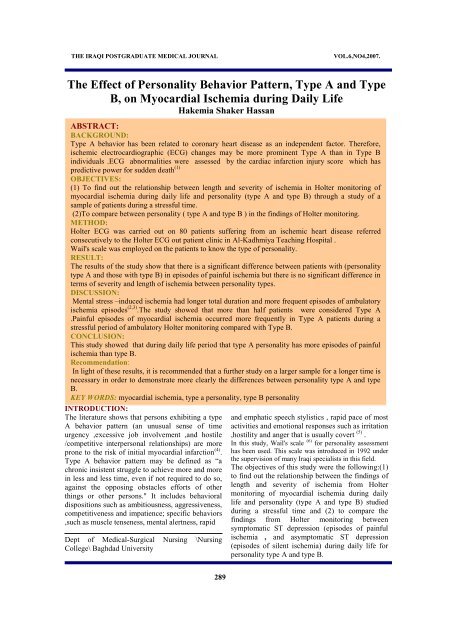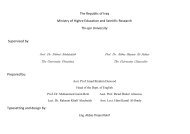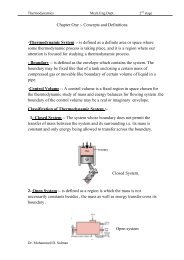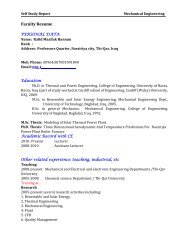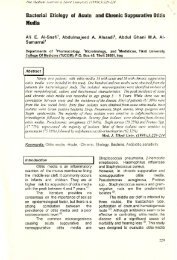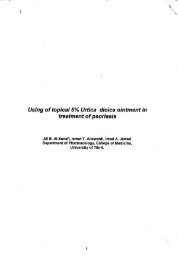The Effect of Personality Behavior Pattern ,Type A and ... - iasj.net
The Effect of Personality Behavior Pattern ,Type A and ... - iasj.net
The Effect of Personality Behavior Pattern ,Type A and ... - iasj.net
You also want an ePaper? Increase the reach of your titles
YUMPU automatically turns print PDFs into web optimized ePapers that Google loves.
PERSONALITY THE IRAQI POSTGRADUATE BEHAVIOR MEDICAL PATTERN JOURNAL VOL.6,NO4,2007.<br />
<strong>The</strong> <strong>Effect</strong> <strong>of</strong> <strong>Personality</strong> <strong>Behavior</strong> <strong>Pattern</strong>, <strong>Type</strong> A <strong>and</strong> <strong>Type</strong><br />
B, on Myocardial Ischemia during Daily Life<br />
Hakemia Shaker Hassan<br />
ABSTRACT:<br />
BACKGROUND:<br />
<strong>Type</strong> A behavior has been related to coronary heart disease as an independent factor. <strong>The</strong>refore,<br />
ischemic electrocardiographic (ECG) changes may be more prominent <strong>Type</strong> A than in <strong>Type</strong> B<br />
individuals .ECG abnormalities were assessed by the cardiac infarction injury score which has<br />
predictive power for sudden death (1)<br />
OBJECTIVES:<br />
(1) To find out the relationship between length <strong>and</strong> severity <strong>of</strong> ischemia in Holter monitoring <strong>of</strong><br />
myocardial ischemia during daily life <strong>and</strong> personality (type A <strong>and</strong> type B) through a study <strong>of</strong> a<br />
sample <strong>of</strong> patients during a stressful time.<br />
(2)To compare between personality ( type A <strong>and</strong> type B ) in the findings <strong>of</strong> Holter monitoring.<br />
METHOD:<br />
Holter ECG was carried out on 80 patients suffering from an ischemic heart disease referred<br />
consecutively to the Holter ECG out patient clinic in Al-Kadhmiya Teaching Hospital .<br />
Wail's scale was employed on the patients to know the type <strong>of</strong> personality.<br />
RESULT:<br />
<strong>The</strong> results <strong>of</strong> the study show that there is a significant difference between patients with (personality<br />
type A <strong>and</strong> those with type B) in episodes <strong>of</strong> painful ischemia but there is no significant difference in<br />
terms <strong>of</strong> severity <strong>and</strong> length <strong>of</strong> ischemia between personality types.<br />
DISCUSSION:<br />
Mental stress –induced ischemia had longer total duration <strong>and</strong> more frequent episodes <strong>of</strong> ambulatory<br />
ischemia episodes (2,3) .<strong>The</strong> study showed that more than half patients were considered <strong>Type</strong> A<br />
.Painful episodes <strong>of</strong> myocardial ischemia occurred more frequently in <strong>Type</strong> A patients during a<br />
stressful period <strong>of</strong> ambulatory Holter monitoring compared with <strong>Type</strong> B.<br />
CONCLUSION:<br />
This study showed that during daily life period that type A personality has more episodes <strong>of</strong> painful<br />
ischemia than type B.<br />
Recommendation:<br />
In light <strong>of</strong> these results, it is recommended that a further study on a larger sample for a longer time is<br />
necessary in order to demonstrate more clearly the differences between personality type A <strong>and</strong> type<br />
B.<br />
KEY WORDS: myocardial ischemia, type a personality, type B personality<br />
INTRODUCTION:<br />
<strong>The</strong> literature shows that persons exhibiting a type<br />
A behavior pattern (an unusual sense <strong>of</strong> time<br />
urgency ,excessive job involvement ,<strong>and</strong> hostile<br />
/competitive interpersonal relationships) are more<br />
prone to the risk <strong>of</strong> initial myocardial infarction (4) .<br />
<strong>Type</strong> A behavior pattern may be defined as “a<br />
chronic insistent struggle to achieve more <strong>and</strong> more<br />
in less <strong>and</strong> less time, even if not required to do so,<br />
against the opposing obstacles efforts <strong>of</strong> other<br />
things or other persons." It includes behavioral<br />
dispositions such as ambitiousness, aggressiveness,<br />
competitiveness <strong>and</strong> impatience; specific behaviors<br />
,such as muscle tenseness, mental alertness, rapid<br />
Dept <strong>of</strong> Medical-Surgical Nursing \Nursing<br />
College\ Baghdad University<br />
<strong>and</strong> emphatic speech stylistics , rapid pace <strong>of</strong> most<br />
activities <strong>and</strong> emotional responses such as irritation<br />
,hostility <strong>and</strong> anger that is usually covert (5) .<br />
In this study, Wail's scale (6) for personality assessment<br />
has been used. This scale was introduced in 1992 under<br />
the supervision <strong>of</strong> many Iraqi specialists in this field.<br />
<strong>The</strong> objectives <strong>of</strong> this study were the following:(1)<br />
to find out the relationship between the findings <strong>of</strong><br />
length <strong>and</strong> severity <strong>of</strong> ischemia from Holter<br />
monitoring <strong>of</strong> myocardial ischemia during daily<br />
life <strong>and</strong> personality (type A <strong>and</strong> type B) studied<br />
during a stressful time <strong>and</strong> (2) to compare the<br />
findings from Holter monitoring between<br />
symptomatic ST depression (episodes <strong>of</strong> painful<br />
ischemia , <strong>and</strong> asymptomatic ST depression<br />
(episodes <strong>of</strong> silent ischemia) during daily life for<br />
personality type A <strong>and</strong> type B.<br />
THE IRAQI POSTGRADUATE MEDICAL JOURNAL 289<br />
VOL.6,NO4,2007.
PERSONALITY BEHAVIOR PATTERN<br />
PATIENTS AND METHODS:<br />
For the purpose <strong>of</strong> achieving the aims, a quasi-<br />
experimental design has been used throughout the<br />
present study during the period from 15th <strong>of</strong> Jan 2007 to<br />
the 15 th <strong>of</strong> Aug 2007.<br />
<strong>The</strong> studied population included 80 patients with<br />
ischemic heart disease referred consecutively to the<br />
Holter ECG out patient clinic in Al-Kadhmiya<br />
Teaching Hospital. <strong>The</strong>se patients were chosen<br />
according to the following criteria<br />
a- <strong>The</strong> patients were diagnosed as having a<br />
definite ischemic heart disease.<br />
b- <strong>The</strong>ir chest pain lasted less than three months<br />
may be due to we hypothesized that type A<br />
behavior pattern has been associated with the onset<br />
<strong>of</strong> myocardial ischemia, so too ,though independly,<br />
has the presence <strong>of</strong> stressful life events in the<br />
period preceding illness.<br />
c- -Informed consent was obtained from the legal<br />
guardians in all cases.<br />
Six patients refused to participate <strong>and</strong> 4 patients<br />
did not complete Wail's scale were excluded from<br />
the study .Thus complete data were collected on 80<br />
patients.<br />
content validity <strong>of</strong> the questionnaire was<br />
determined through a panel <strong>of</strong> (10) experts in Al-<br />
Kadhmia Teaching Hospital <strong>and</strong> Ibn –Al-Beitar<br />
hospital .<br />
<strong>The</strong> persons who scored more than 36 were<br />
regarded as <strong>Type</strong> A personality, where as persons<br />
who scored less than 36 were regarded as <strong>Type</strong> B<br />
personality (Appendix 1).<br />
Statistical Analysis<br />
Mean- St<strong>and</strong>ard deviation <strong>and</strong> T-test value were<br />
computed to estimate the differences between the<br />
two types <strong>of</strong> personality (<strong>Type</strong> A& <strong>Type</strong> B)<br />
Chi- square test <strong>and</strong> Kolmogorve- Smirnove test<br />
used two samples to determine the significant<br />
I Expression <strong>of</strong> anger 16 items<br />
II Competition <strong>and</strong> Ambition 15 items<br />
III Need to control 13 items<br />
IV Impatience 11 items<br />
V Rapidity 10 items<br />
VI Aggressiveness 7 items<br />
Internal consistency reliability was employed for<br />
the determination <strong>of</strong> the questionnaire's reliability<br />
Alpha. correlation coefficient was computed <strong>and</strong><br />
indicated that r=0.96 which was adequately<br />
reliable.<br />
Ambulatory monitoring <strong>of</strong> twenty four hour period<br />
a day was performed using a modified inferior lead<br />
<strong>and</strong> a percordial lead corresponding to the<br />
maximum ST depression with daily life<br />
activity.Quick prop electrodes <strong>and</strong> Oxford medilog<br />
11 recorders were used .<strong>The</strong> patients were<br />
encouraged to return to normal active life style <strong>and</strong><br />
complete extensive diaries to record the severity<br />
<strong>and</strong> activity <strong>of</strong> their typical attacks <strong>of</strong> palpitation or<br />
chest pain .<strong>The</strong>y were also encouraged to write in<br />
the diary any other activities such as walking<br />
,working ,eating <strong>and</strong> the times they went to bed. In<br />
addition ,an analysis <strong>of</strong> the tapes was performed on<br />
the Oxford system mediolg 11 analyzer.<br />
An episode <strong>of</strong> transient ST segment depression was<br />
defined as horizontal ST –depression <strong>of</strong> at least 0.1<br />
MV measured 0.05 second after J point during<br />
daily life, compared to the resting ST-segment<br />
Wail's scale (6) for the assessment <strong>of</strong> personality<br />
behaviour pattern was employed on the patients<br />
.<strong>The</strong> scale is composed <strong>of</strong> 72 items on the<br />
following fields:<br />
difference between the findings <strong>of</strong> Holter about<br />
personality (<strong>Type</strong> A & <strong>Type</strong> B)<br />
Kolmogorve- Smirnove test was considered the<br />
most appropriate non –parametric test for the<br />
purpose <strong>of</strong> the project study <strong>and</strong> it was interchange<br />
ably used with Chi-square ,in cases where the<br />
frequencies in each cell in the rows or the columns<br />
had less than five frequencies<br />
THE IRAQI POSTGRADUATE MEDICAL JOURNAL 290<br />
VOL.6,NO4,2007.
PERSONALITY BEHAVIOR PATTERN<br />
RESULTS:<br />
Table :(1) Demographic characteristics <strong>of</strong> patients with ischemic heart disease<br />
<strong>Type</strong> A <strong>Type</strong> B<br />
No. % No. %<br />
Sex<br />
Male 32 57.14 10 41.66<br />
Female 24 42.85 14 58.33<br />
Total 56 100 24 100<br />
Age<br />
21-30 18 32.14 2 8.33<br />
31-40 10 17.85 6 25<br />
41-50 8 14.28 6 25<br />
51-60 12 21.42 4 16.66<br />
61-70 6 10.71 6 25<br />
71-80 2 3.57 - -<br />
Total 56 100 24 100<br />
Mean 42.64 48<br />
Table-1- showed that 32 (57.14% ) <strong>of</strong> patients type A were males <strong>and</strong> the mean age was (42.64) while 10(41.66%) <strong>of</strong><br />
patients type B were males <strong>and</strong> the mean age was(48).<strong>The</strong>y range between (21-80) years.<br />
Table :(2) Comparison between personality type A <strong>and</strong> personality type B <strong>of</strong> patients with ischemic heart<br />
disease<br />
<strong>Personality</strong> Freq %<br />
<strong>Type</strong> A 56 70<br />
<strong>Type</strong> B 24 30<br />
Total 80 100<br />
Table (2) showed that the total number <strong>of</strong> patients (personality type A) was 56 (70%)while the total number <strong>of</strong><br />
patients (personality type B) was 24 (30%)<br />
Table:(3)Comparison <strong>of</strong> symptomatic <strong>and</strong> asymptomatic ST segment depression between personality <strong>Type</strong> A<br />
<strong>and</strong> <strong>Type</strong> B<br />
Characteristics<br />
<strong>Type</strong> A <strong>Type</strong> B Chi-square<br />
No. No.<br />
Symptomatic ST depression(episodes <strong>of</strong> painful ischemia) 38 8 S<br />
Asymptomatic ST depression(episodes <strong>of</strong> silent ischemia) 18 16 N.S<br />
Total 56 24 S<br />
,S=significant,<br />
N.S=non significant<br />
No.=number<br />
Table–3- showed that type A patients reported significantly more episodes <strong>of</strong> ischemic pain (symptomatic ST<br />
depression) than type B in 24 hours Holter ECG ,while there was no significant difference between the two groups in<br />
the number <strong>of</strong> episodes <strong>of</strong> silent ischemia (Asymptomatic ST depression) when analyzed by Chi-square.<br />
THE IRAQI POSTGRADUATE MEDICAL JOURNAL 291<br />
VOL.6,NO4,2007.
PERSONALITY BEHAVIOR PATTERN<br />
Table :(4) Comparison <strong>of</strong> heart rate during daily life on the 24 hours Holter ECG for type A personality <strong>and</strong><br />
type B personality<br />
Heart rate during daily life<br />
N.S=non significant<br />
Table -4- revealed that there is no significant difference between patients (personality type A <strong>and</strong> type B ) in heart<br />
rate during daily life on the 24 hours Holter ECG <strong>and</strong> their heart rate ranged between (80-120) beats per minutes<br />
Table: (5)Duration <strong>and</strong> Length <strong>of</strong> ischemia during daily life on the 24 hours Holter ECG for group type A <strong>and</strong><br />
group type B<br />
Mean length <strong>of</strong> ischaemia per<br />
episodes (min)<br />
N.S=non significant; min=Minute<br />
Table 5 showed that there is no significant difference between patients (personality type A <strong>and</strong> type B ) in length <strong>of</strong><br />
ischemia per episodes <strong>and</strong> total mean ischemic time during daily life on the 24 hours Holter ECG .<br />
Table :(6) severity <strong>of</strong> ischemia during daily life on 24 hours Holter ECG for group type A <strong>and</strong> group type B<br />
K.S=).Kolmogorve Smirnove; N.S=non significant<br />
Table 6 showed that there is no significant difference between patients (personality type A <strong>and</strong> type B) in severity <strong>of</strong><br />
ischemia during daily life on the 24 hours Holter ECG .<br />
DISCUSSION:<br />
Coronary artery disease patients showed a<br />
disposition to take more responsibility at work,<br />
working more hours overtime, obtaining less<br />
satisfaction from their jobs, expressing greater<br />
hostility when slowed down by others, <strong>and</strong> feeling<br />
more dissatisfaction with their educational level<br />
<strong>and</strong> achievement <strong>of</strong> life goals (7) .<br />
In relation to age ,the findings showed that the<br />
mean age for personality type A was (42.64) while<br />
the mean age for the personality type B was (48)<br />
(Table 1). Another study (3) reported that patients<br />
whose age was between (40-59) years old showed<br />
an increased risk <strong>of</strong> coronary artery disease in men<br />
<strong>and</strong> women with “ type A” personality.<br />
This study showed that “type A” patients reported<br />
more angina than “type B” <strong>and</strong> suggested a greater<br />
severity <strong>of</strong> disease or more acuity to account for it<br />
(table2). Another study (2,8) reported that the history<br />
<strong>of</strong> angina or heart attack was positively associated<br />
with type A personality.<br />
<strong>Type</strong> A <strong>Type</strong> B t-test C.S<br />
X SD X SD<br />
119.35 31.07 116.08 25.30 0.68 N.S<br />
<strong>Type</strong> A <strong>Type</strong> B t-test C.S<br />
X SD X SD<br />
12.93 5.39 14.13 4.52 1.55 N.S<br />
Total mean ischemic time (min) 104.5 7.78 107.20 26.97 0.48 N.S<br />
Characteristics <strong>Type</strong> A <strong>Type</strong> B K.S<br />
ST depression<br />
More than 2 mm<br />
NO NO<br />
10 8 N.S<br />
“<strong>Type</strong> A” behavior pattern is a characteristic which may<br />
best be demonstrated in response to an environmental or<br />
psychological stress such as that which we have<br />
described in the study . In “type A” patients ,there were<br />
significantly more episodes <strong>of</strong> painful ischemia than<br />
“type B” patients <strong>and</strong> the number <strong>of</strong> episodes <strong>of</strong> silent<br />
ischemia was not significantly different in “type A” <strong>and</strong>”<br />
type B” (table 3).<br />
Regarding the analysis <strong>of</strong> the heart rate in the<br />
minutes before the onset <strong>of</strong> ST-depression, there<br />
were no significantly different increase in heart rate<br />
<strong>of</strong> personality “type A” compared with personality<br />
“type B” (Table 4). A study (9) reported that “type<br />
A” patients had a lower threshold for reporting all<br />
events including ischemia as painful .Certainly<br />
they reported more situations as stressful<br />
(emotional upset) at the time <strong>of</strong> stress as compared<br />
to the later date. This has been noted in type A<br />
subjects (table 3).This finding was similar to many<br />
other findings in the literature (Cole et. al.,<br />
2001,Case etal.,1993 <strong>and</strong> Hey et al., 1993 <strong>and</strong><br />
THE IRAQI POSTGRADUATE MEDICAL JOURNAL 292<br />
VOL.6,NO4,2007.
PERSONALITY BEHAVIOR PATTERN<br />
Larson,1993) which suggested that ischemic<br />
response <strong>of</strong> the “type A” patient at the time <strong>of</strong><br />
stress may not have been due to the acute hypoxia<br />
effect <strong>of</strong> anxiety or increased activity, but rather to<br />
the changes which alter the threshold for ischemia<br />
.It has been suggested that the behavioral pattern<br />
mediates its effect through an increased adrenergic<br />
tone .This might have an effect in increasing a<br />
peripheral resistance or coronary tone ,<br />
predisposing to myocardial ischemia at lower heart<br />
rates.<br />
CONCLUSION:<br />
This study concludes that ,during a stressful period<br />
,<strong>Type</strong> A patients did not have more total ischemia<br />
but more painful episodes. <strong>The</strong>y are thus more<br />
likely to present to a physician at an earlier date,<br />
receive maximum antianginal medication sooner<br />
<strong>and</strong> be <strong>of</strong>fered Holter ECG monitoring more<br />
promptly than “type B”. This, therefore, may be<br />
one reason why “type A” behavior pattern may be<br />
considered as a risky factor for a coronary artery<br />
disease in some studies.<br />
REFERENCES:<br />
1.Larson J :New perspectives on <strong>Type</strong> A behavior:<br />
a psychiatric point <strong>of</strong> view; International Journal<br />
Psychiatry Med ; 1993; 23: 179-94<br />
2.Cas-L; Metra M; Nodari S; Nardi M; Giubbini<br />
R.Stress <strong>and</strong> ischemic heart disease .Cardiologia<br />
Journal ; 1993 ; 38(12 Suppl 1): 415-25<br />
3.Sykes D;Arveiler D;Salters C;Ferrieres J;Mccrum<br />
E;Ampuyel P;Bingham: Psychosocial risk factors for<br />
heart disease in France <strong>and</strong> Northern Irel<strong>and</strong> : the<br />
Prospective Epidemiological study <strong>of</strong> Myocardial<br />
infarction; International Journal Epidemiol ; 2002<br />
;31:1227-34<br />
4.Cole S;Kawachi I;Liu S;Gaziano J;Manson<br />
J;Hannekens C: Time urgency <strong>and</strong> risk <strong>of</strong> non fatal<br />
myocardial infarction ;International Journal Epidemiol<br />
2001;30 :363-9<br />
5.Case L; Metra M;Nodari S;Nardi M;Giubbini<br />
R;Visioli: Stress <strong>and</strong> ischemic heart disease<br />
;Cardiologia Journal 1993; 38,415-25<br />
6.Ali ,Wail Fathil :<strong>Personality</strong> <strong>Pattern</strong> <strong>and</strong> Psychological<br />
Status <strong>and</strong> <strong>The</strong>ir <strong>Effect</strong> on Heart Coagulum<br />
(1993),MA thesis in psychology ,University <strong>of</strong><br />
Baghdad ( written in Arabic)<br />
7.Hey:<strong>Type</strong> A behaviour <strong>and</strong> coronary artery disease<br />
.Chung Hua Hisin Kuan ping Tsa; 1991;19, 214-267<br />
8.Littman A; Fava M; Halperin P; Lamon S; Drews<br />
F;Oleshansky M; Bielenda C; MacLaughlin R<br />
:Physiologic benefits <strong>of</strong> a stress reduction program<br />
for healthy middle-aged army <strong>of</strong>ficers; Psychosom-<br />
Res Journal 1993 ; 37, 345-54<br />
9.Flodmark B;Ase G :Musculoskeletal symptoms <strong>and</strong><br />
type A behavior in blue collar workers ; British<br />
Medical Journal ;1992; 49, 683-7<br />
THE IRAQI POSTGRADUATE MEDICAL JOURNAL 293<br />
VOL.6,NO4,2007.


